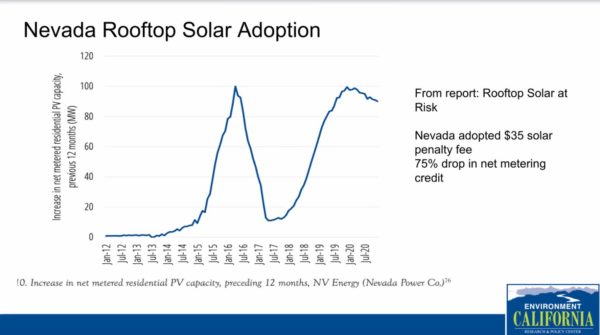The California Public Utilities Commission (CPUC) unanimously voted to approve Net Energy Metering 3.0 (NEM), slashing payments for excess solar production sent to the grid by 75%.
CPUC voted cut the average export rate in California from $0.30 per kWh to $0.08 per kWh, making the cuts effective on April 15, 2023. Customers who have new systems installed and approved for grid interconnection before the effective date in April will be grandfathered in to NEM 2.0 rates.
During the vote, the Commission said the balancing of costs and benefits continue to be “quite generous” under the decision.
Currently, average net metering rates range from $0.23 per kWh to $0.35 per kWh, and the new proposed decision cuts those rates to an average of $0.05 per kWh to $0.08 per kWh. This is set to be the largest cut of export rates in U.S. history, in a market that represents roughly 50% of the nation’s residential solar market.
Payments were cut as a result of a reported cost shift where non-solar owners cross-subsidize solar owners for maintaining the grid. The utility-backed concept suggests poorer Californians are paying higher utility rates to pay for lost profits that utilities endure in order to pay solar owner for delivering clean energy to the grid.
Lawrence Berkeley National Laboratory studied the effect, and found that for the vast majority of states and utilities, the effects of distributed solar on retail electricity prices will likely remain negligible for the foreseeable future.” The study found that distributed solar “likely entails no more than a 0.03 cent/kWh long-run increase in U.S. average retail electricity prices, and far smaller than that for most utilities.”
As exported power loses its value, Californians now have their hand forced to adopt batteries with their solar installations if they want a reasonable return on investment. Return on investment periods are estimated to move from an average of about 4.5 years to 6.5 years to 14.5 years, said Centrica Business Solutions.
“We believe this would represent a potential 70-85% drop in economic value for solar-only systems, which would suggest California would effectively become a 100% solar and storage end market, which ultimately makes solar much less accessible and affordable,” wrote Phil Shen, managing director, ROTH Capital Partners.
The Solar Energy Industries Association (SEIA) said the decision is “too abrupt” and will slow rooftop solar deployment in the state. “The failure to adopt a more gradual transition to net billing risks putting solar out of reach for millions of residents across the state,” said SEIA.
In 2016 to 2018, the state of Nevada went through massive oscillations in rooftop solar deployment after a similar net metering value reduction was approved. A $35 solar penalty fee, and a 75% drop in fees led to a nearly 90% drop in rooftop deployment growth in the state.

“California’s residential solar segment could be down 30% year-over-year in the 12 months after this becomes effective,” wrote Shen.
The California Solar and Storage Association (CALSSA) said the state is currently installing roughly 30,000 batteries compared to 200,000 solar systems. High costs, supply chain constraints, inflation and permitting and interconnection delays and challenges means it could take years for storage to catch up to solar, said CALSSA.
Currently roughly 1.5 million consumers in California use net metering, including thousands of churches, farms, and affordable housing units. In total, 13 GW of distributed solar capacity has been installed across the state, the size of six Diablo Canyon nuclear sites.
Rooftop solar is valued for its ability to efficiently deliver clean power, limit the amount of transmission infrastructure needed to support generation, provide backup power and grid services, support small business, and more.
The CPUC found that California must triple the amount of local, distributed solar to reach the clean energy mandate laid out by the state’s Senate Bill 100. The California Solar and Storage Association forecast rooftop solar could save California ratepayers $120 billion by 2050, or $300 per person per year.
(Read: “Coalition received $1.7 million from three California utilities to push NEM 3.0, a rooftop solar ‘killer’“)
Environment California found that, based on a state regulator estimated deployment of 28.5 GW of rooftop solar through 2045, rooftop solar could prevent the development of 148,000 acres of land versus a centralized utility-scale-only model. That is an area about half the size of Los Angeles that could be preserved.
“[The decision] comes as climate-related disasters continue to intensify and the electric grid remains vulnerable to aging infrastructure and volatile global energy markets,” said SEIA. “Distributed solar and storage helps strengthen the grid and boost our resilience to these threats.”
Mark Jacobson, fellow and professor of civil and environmental engineering at Stanford University, said rooftop solar is important in protecting human health and minimizing risks. Replacing overhead wiring, overloaded transformers, and natural gas piping, rooftop solar replaces harmful and dangerous infrastructure from the built environment.
“The argument this proposal will help disadvantages communities is wrong… it will disproportionately kill them,” said Jacobson.
In 2017, electric utility PG&E’s downed transmission wires were found to be the cause of massive wildfires and leaving many Californians without homes. The company was stuck with a $7.5 billion bill as it was found at fault for negligence in maintaining vegetation around its centralized transmission wires. These costs incurred by the utilities are harmful to all Californians, as the financial fallout from these disasters is picked up by ratepayers in the form of a higher bill.
CALSSA called the new decision a “loser” for California. “For the solar industry, it will result in business closures and the loss of green jobs. For middle class and working class neighborhoods where solar is growing fastest, it puts clean energy further out of reach. For our grid reliability needs, it fails to promise robust growth in battery storage. And for California’s race to clean energy, it puts us behind our goals and out of step with the national pro-solar agenda,” said Bernadette Del Chiaro, executive director, CALSSA.



